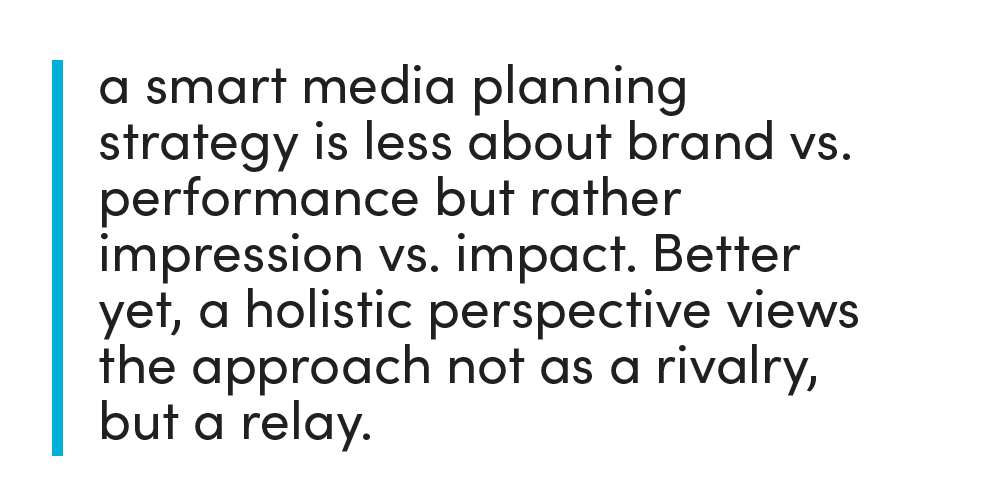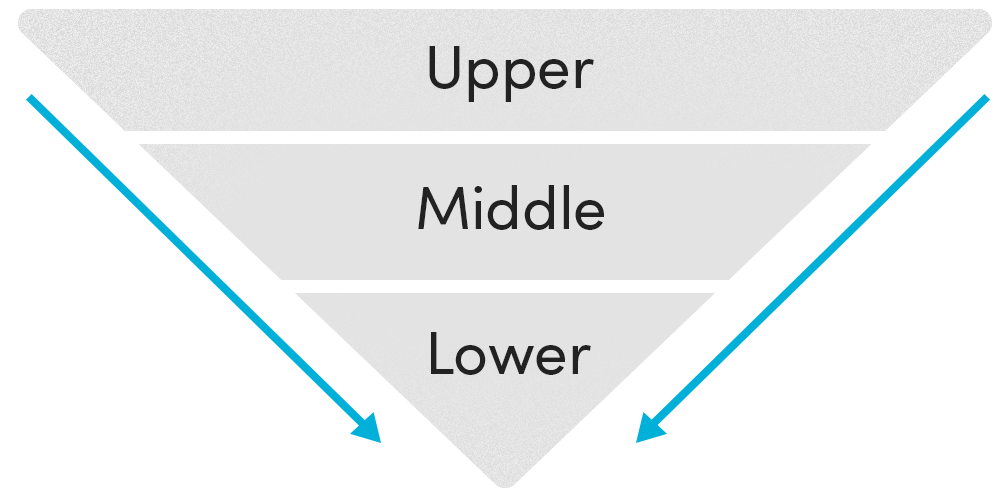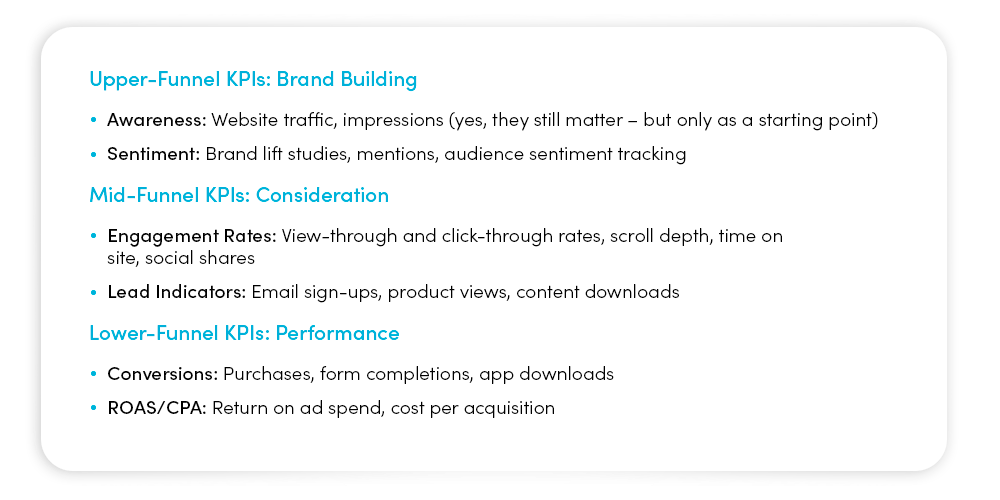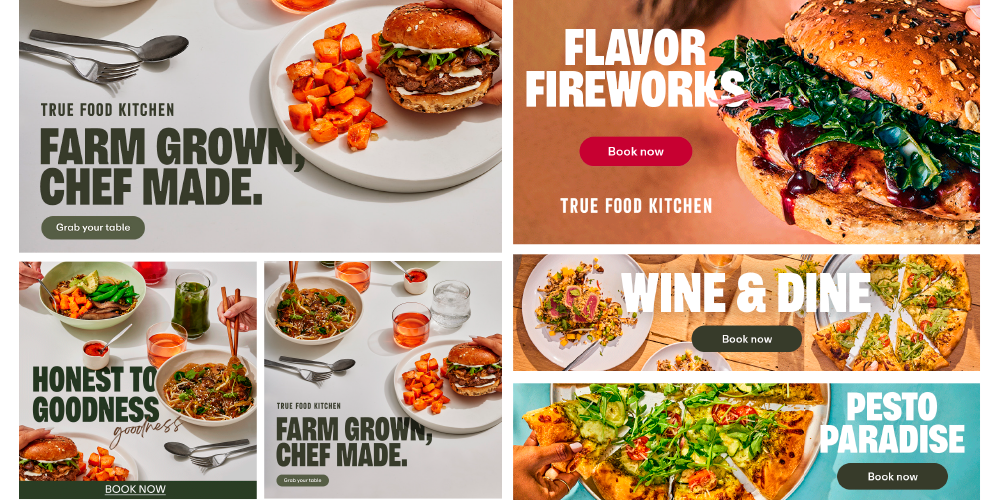Finding your place in the funnel can be a challenge for many marketers, especially when tight budgets might mean difficult choices. When every dollar counts, many brands feel pressured to funnel their budgets straight to the bottom through short-term performance marketing tactics. On the other hand, some brands might believe that simply the bigger the audience, the better – at least then your message is out there, right?
Pitting brand vs. performance marketing against each other, however, rarely leads to lasting results when they’re not tied to meaningful KPIs. Every part of the funnel plays a role, and a true full-funnel approach balances upper-funnel brand awareness with lower-funnel performance tactics to drive both long-term equity and short-term results, each measured according to its end goal.

In other words, a smart media planning strategy is less about brand vs. performance but rather impression vs. impact. Better yet, a holistic perspective views the approach not as a rivalry, but a relay. Brand-building creates the emotional foundation and awareness that fuels lower-funnel conversion, and when each leg of the relay is measured according to its place and purpose, your campaign can cross the finish line. So, let’s start at the beginning: We’ll clarify how each phase of the funnel relates to the next, explain why your measurements shouldn’t stop just with easy-to-earn vanity metrics, and uncover how data should be validated with meaningful engagement or business outcomes.
Full-Funnel Marketing: From Top to Bottom
To stay the course, a well-rounded media planning strategy incorporates each phase of the marketing funnel, passing the baton from one phase to the next. Brand marketing tactics create awareness at the top, while performance marketing tactics drive conversions at the bottom. And remember that in today’s connected world, audiences can encounter your brand – or enter your funnel – at any stage, and not necessarily in order. Even so, a well-defined funnel structure helps clarify the goals and metrics for each of your marketing tactics.

Upper-Funnel
The top of the funnel helps create awareness of your brand and provides the fuel for the rest of your funnel. This is where you introduce your brand to potential customers through campaigns that tell your story, build familiarity, and prime your audience. Creating awareness isn’t about immediate sales, but rather about generating curiosity among your audiences and establishing familiarity. Tactics may include brand videos, sponsorships, organic social media campaigns, thought leadership content, and proactive PR.
Mid-Funnel
Once people know who you are, they’ll start weighing whether you’re worth their time or money. This moves them into the engagement and consideration phase of the funnel through campaigns focused on nurturing the relationship with your brand. Mid-funnel tactics often address your audience’s pain points and present the value of your brand, such as customer testimonials and case studies, email newsletters, helpful webinar demos, and social engagement through community management.
Lower-Funnel
The bottom of the funnel is the moment of truth, and ideally, the payoff from the groundwork you’ve laid in the previous two phases. This phase focuses on providing the final nudge or the most direct information that will prompt browsers to become customers. Strategic performance marketing tactics help customers cross the finish line, whether through paid search, email offers, compelling landing pages, product demos, or retargeted ads with special promotions. But whatever the tactic, strong calls to action and clear paths to purchase are essential.
Finding the KPIs That Fit
With an understanding of the full marketing funnel in mind, it’s easier to see how placing too much emphasis on bottom-of-the-funnel performance marketing can be like a sprinter trying to run a marathon – you might start fast with quick conversions, but you won’t last with brand advocates and returning customers. Similarly, not all marketing tactics and media placements can be measured by conversions, and yet not all awareness metrics can be trusted as indicators of real impact.
If each leg of the relay serves a different function, then each one must also be measured by different metrics. One of the most common missteps we see in media planning is using the same KPI to judge every tactic, when every channel — and every part of the funnel — deserves its own set of meaningful KPIs. You wouldn’t grade an email campaign by video views, or a brand awareness campaign by purchases alone. Instead, here are some metrics to think about with each phase of your funnel that can help identify impact and prevent falling into the trap of relying on vanity metrics:

According to McKinsey and Company, shifting greater media allocation to areas with higher returns and optimizing campaigns through a test-and-learn approach can lead to a 15 to 20 percent lift in marketing ROI. So, it’s not about picking one set of metrics — instead, it’s about choosing the right KPIs for the right moment in the customer journey.
A Real-Life Example
Here at (amp), we’re committed to helping clients get the most out of their media spend through strategic, full-funnel marketing. We recently partnered with True Food Kitchen (TFK) to deliver quick returns and long-term brand growth for their private equity investors.
When TFK approached us, they needed a robust marketing communications plan and media strategy that would demonstrate growth to their new investors by driving sales at their brick-and-mortar locations and increasing usage of their online ordering platform. We knew achieving these goals was crucial to quickly proving business impact for TFK’s new investors, but we also knew we’d need to enhance overall brand visibility if we wanted to create long-term brand-building growth.
So, our initial creative and media strategy for TKF involved targeting segmented store locations alongside a national audience across all markets. We developed two distinct campaigns that not only heightened brand visibility but also substantially boosted online orders and reversed a 5-year declining performance trend. Together, the campaigns exemplified the power of a strategic, multi-channel approach, even in the face of unexpected hurdles, including payment outages that caused ad delivery issues and a literal storm (Hurricane Hilary).

Making an Impact
Our work with TFK demonstrated that a successful media plan today isn’t about conversions at all costs – it’s about balance, precision, and adaptation. Instead of just chasing numbers, we help clients build full-funnel systems that connect, convert, and continue to count over time. Whether you’re looking for ways to optimize your funnel, refine your data measurement, or build out a full-funnel strategy from top to bottom, our team of experts at (amp) is here to help your brand make an impression and leave an impact. Contact us today to get started!
